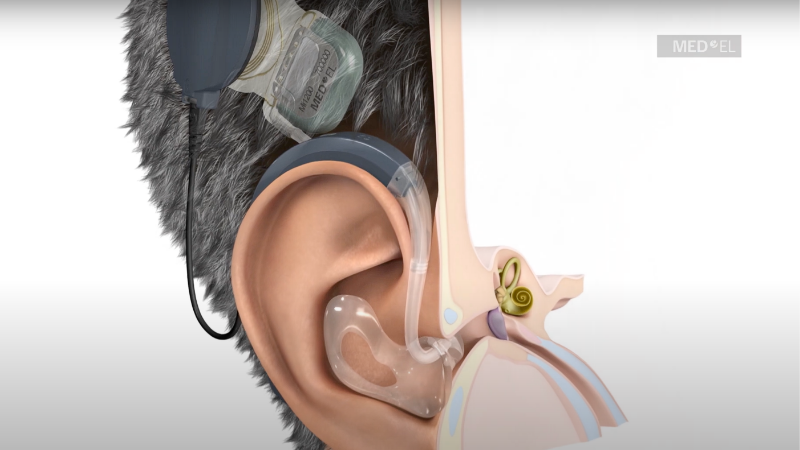
MED-EL
Published May 21, 2014
5 Ways To Identify High-Frequency Hearing Loss
Electric Acoustic Stimulation, or EAS is a special combination of two different hearing loss solutions designed for one very special type of hearing loss called high frequency hearing loss.

What Is High Frequency Hearing Loss?
High frequency hearing loss (sometimes called “Partial Deafness”) is similar to sensorineural hearing loss, and occurs when the hair cells in the cochlea are missing or damaged.
As we showed in our post about how the cochlea hears sounds, high-frequency sounds are perceived in the bottom of the cochlea and low-frequency sounds are in the top. Because of this, it’s common for hearing loss to happen in the high-frequencies before it happens in the low frequencies.
When this occurs, and the cochlea is still able to understand some low-frequency sounds but no high-frequency sounds, the hearing loss is called “high frequency hearing loss”. This means that someone with high frequency hearing loss will be able to hear sounds like the roll of thunder, but will have difficulty hearing with sounds like the letters F, S, or K, and female voices. There are lots of different reasons why high frequency hearing loss occurs, including exposure to noise, ageing, or genetics.
EAS: Two Solutions For Two Hearing Losses
An ideal treatment for high frequency hearing loss is Electric Acoustic Stimulation, and by looking at its name we can see what makes it such a unique hearing implant. It’s the only type of hearing implant that combines both electric stimulation, which is sending electrical pulses directly to the nerve cells in the inner ear like a cochlear implant does, and acoustic amplification, like a hearing aid.
This combination of stimulation is ideal for someone with high frequency hearing loss because it helps to reproduce the high-frequency sounds with electric stimulation, while using acoustic amplification to take care of the low-frequency residual hearing.
The electric stimulation is necessary to reproduce the high-frequency sounds because it can stimulate the cochlea even when no hair cells are present. It’s done with a cochlear implant and an electrode array designed specifically for high-frequency hearing loss.
But, because some hair cells in the low-frequency region still work (called “residual hearing”), the goal is to take full advantage of each and every one of these remaining hair cells. This is done with a solution that’s much different from a CI, and very straightforward: turning up the volume. Like a hearing aid, the EAS system sends amplified sounds to the cochlea along the ear’s natural hearing path.
This way, both the high-frequency and low-frequency hearing losses each get unique and targeted treatment to provide the best possible hearing.
If you’re more of a visual person , here’s a quick video that shows how the electric and acoustic stimulation combines in the ear:
Do I Might Have High-Frequency Hearing Loss?
Here are a few sample questions that you can ask yourself (or a loved one) to get information about your hearing. You can also find out more about what it’s like to have high-frequency hearing loss by visiting our Hearing Loss Stories.
- Do you have trouble following conversations when multiple people speak at one time?
- Do you have difficulty understanding when using the telephone?
- Does speech seem muffled?
- Do you have difficulties hearing door bells or birds singing?
- Can you hear male voices, but have difficulties hearing female voices?
If you said “yes” to any of these questions you might have high frequency hearing loss, and it would be a good idea to get in touch with a hearing professional for a complete hearing test and medical diagnosis.
EAS has been the ideal solution for high frequency hearing loss for the last 15 years. The first experiments into combining electric and acoustic stimulation were started in 1999Von Ilberg et al. Electric-acoustic stimulation of the auditory system. ORL, 1999; 61: 334-340.[1]. Since then, EAS has been developed and refined into a powerful system that gives hearing and listening scores of up to 50 percentage points higher than using hearing aids alone.
Visit the MED-EL website to learn more about solutions to treat high-frequency hearing loss.
References
-
[1]
Von Ilberg et al. Electric-acoustic stimulation of the auditory system. ORL, 1999; 61: 334-340.
References

MED-EL
Was this article helpful?
Thanks for your feedback.
Sign up for newsletter below for more.
Thanks for your feedback.
Please leave your message below.
Thanks for your message. We will reply as soon as possible.
Send us a message
Field is required
John Doe
Field is required
name@mail.com
Field is required
What do you think?
© MED-EL Medical Electronics. All rights reserved. The content on this website is for general informational purposes only and should not be taken as medical advice. Contact your doctor or hearing specialist to learn what type of hearing solution suits your specific needs. Not all products, features, or indications are approved in all countries.

MED-EL

MED-EL



